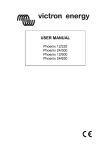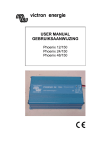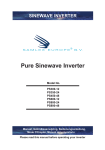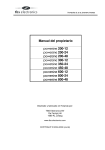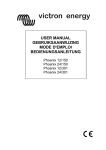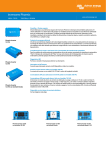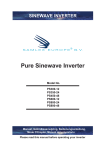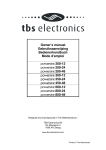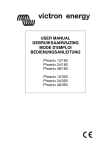Download USER MANUAL GEBRUIKSAANWIJZING
Transcript
USER MANUAL GEBRUIKSAANWIJZING Phoenix 12/225 Phoenix 24/275 Phoenix 12/450 Phoenix 24/600 Copyrights © 1999, 2000 Victron Energie B.V. All Rights Reserved This publication or part thereoff, may not reproduced in any form by any method, for any purpose. VICTRON ENERGIE B.V. MAKES NO WARRANTY, EITHER EXPRESSED OR IMPLIED, INCLUDING BUT NOT LIMITED TO ANY IMPLIED WARRANTIES OF MERCHANTABILITY OR FITNESS FOR A PARTICULAR PURPOSE, REGARDING THESE VICTRON ENERGIE PRODUCTS AND MAKES SUCH VICTRON ENERGIE PRODUCTS AVAILABLE SOLELY ON AN “AS-IS” BASIS. IN NO EVENT SHALL VICTRON ENERGIE B.V. BE LIABLE TO ANYONE FOR SPECIAL, COLLATERAL, INCIDENTAL, OR CONSEQUENTIAL DAMAGES IN CONNECTION WITH OR ARISING OUT OF PURCHASE OR USE OF THESE VICTRON ENERGIE PRODUCTS. THE SOLE AND EXCLUSIVE LIABILITY TO VICTRON ENERGIE B.V., REGARDLESS OF THE FORM OF ACTION, SHALL NOT EXCEED THE PURCHASE PRICE OF THE VICTRON ENERGIE PRODUCTS DESCRIBED HERE IN. For conditions of use and permission to use this manual for publication in other than the English language, contact Victron Energie B.V. Victron Energie B.V. reserves the right to revise and improve its products as it sees fit. This publication describes the state of this product at the time of its publication and may not reflect the product at all times in the future. 2 manual SECTIONS Page English Nederlands 4 23 manual 3 INTRODUCTION Victron Energie has established an international reputation as a leading designer and manufacturer of energy systems. Our R&D department is the driving force behind this reputation. It is continually seeking new ways of incorporating the latest technology in our products. Each step forward results in value-added technical and economical features. Our proven philosophy has resulted in a full range of state-of-the-art equipment for the supply of electrical power. All our equipment meets the most stringent requirements. Victron Energie energy systems provide you with high quality AC supplies at places where there are no permanent sources of mains power. An automatic stand-alone power system can be created with a configuration comprising of a Victron Energie inverter, battery charger and last but not least, batteries with sufficient capacity. Our equipment is suitable for countless situations in the field, on ships or other places where a mobile 230 VoltAC power supply is indispensable. Victron Energie has the ideal power source for all kinds of electrical appliances used for household, technical and industrial purposes, including instruments susceptible to interference. All of these applications require a high quality power supply in order to function properly. Victron Energie Phoenix sinewave inverter This manual contains instructions for installing the Phoenix 12/225, Ph 24/275, Ph 12/450 and Ph 24/600 sinewave inverters. It describes the functionality and operation of the Phoenix inverter, including its protective devices and other technical features. Note: where the abbreviation ‘Ph’ is used please read ‘Phoenix’ instead. 4 manual CONTENTS INTRODUCTION ..............................................................4 1. INSTALLATION ............................................................6 1.1 Location of the inverter 1.2 Battery requirements 1.3 Connection to the battery 1.3.1 General precautions when working with batteries 6 7 8 8 1.4 Connecting the load 1.5 Turning the inverter on 1.6 Using the Power Save Mode (PSM) on the Ph 12/450 and Ph 24/600 models 10 11 12 2. SELF DIAGNOSIS SYSTEM / TROUBLESHOOTING................................................13 2.1 The flash sequence table 2.2 Acoustic messages 2.3 Troubleshooting guidelines 13 14 14 3. TECHNICAL DATA .....................................................18 3.1 Phoenix 12/225 and Phoenix 24/275 3.2 Phoenix 12/450 and Phoenix 24/600 18 19 4. BATTERY CAPACITY.................................................21 manual 5 1. INSTALLATION 1.1 Location of the inverter FAN y x 1 2. 3 4 5 1 2 Ceiling mounting (inverted). Base mounting. Vertical wall mounting, fan at bottom. FAN 3 4 5 Not recommended OK OK .: (beware of small objects falling through the ventilation openings on top). Not recommended Vertical wall mounting, fan on top. Horizontal wall mounting. OK For best operating results, the inverter should be placed on a flat surface. To ensure a trouble free operation of the inverter, it must be used in locations that meet the following requirements : a) Avoid any contact with water. Do not expose the inverter to rain or moisture. b) Do not place the unit in direct sunlight. Ambient air temperature should be between 0 °C and 40 °C (humidity < 95% non condensing). Note that in extreme situations the inverter’s case temperature can exceed 70 °C. c) Do not obstruct the airflow around the inverter. Leave at least 10 centimetres clearance around the inverter. When the inverter is running too hot, it will shut down. When the inverter has reached a safe temperature level the unit will automatically restart again. 6 manual 1.2 Battery requirements For correct operation, the battery voltage should be between 0.92xVnom and 1.25xVnom where Vnom is 12V or 24V depending on the model, and must be able to supply sufficient current to your inverter. The following table displays the recommended battery capacity per inverter type : Inverter type : Iin at Pnom : Ph 12/225 Ph 24/275 Ph 12/450 Ph 24/600 25 Adc 13 Adc 45 Adc 27 Adc Recommended battery capacity: ≥ 100 Ah ≥ 60 Ah ≥ 200 Ah ≥ 100 Ah The inverter shuts down when the battery voltage is below 0.88xVnom or above 1.3xVnom. In a low or high battery situation the inverter generates one beep per second. THE Ph 12/225 AND Ph 12/450 MUST BE CONNECTED ONLY TO A 12V BATTERY. The inverter will not operate from a 6V battery. The inverter will be damaged when the battery voltage is higher than 16V. CAUTION THE Ph 24/275 AND Ph 24/600 MUST BE CONNECTED ONLY TO A 24V BATTERY. The inverter will not operate from a 12V battery. The inverter will be damaged when the battery voltage is higher than 31V. manual 7 1.3 Connection to the battery The Ph 12/225 and Ph 24/275 are equipped with two 4 mm² wires with a length of 1.5 meters. The Ph 12/450 and Ph 24/600 are equipped with two 10 mm² wires with the same length. If it is unavoidable to extend these wires, use a wire gauge of at least 1.5 times larger than the ones supplied with the inverter. Maximum recommended battery wire length is approx. 3 meters. 1.3.1 General precautions when working with batteries 1. 2. 3. 4. 5. Working in vicinity of a lead acid battery is dangerous. Batteries can generate explosive gases during operation. Never smoke or allow a spark or flame in the vicinity of a battery. Provide sufficient ventilation around the battery. Wear eye and clothing protection. Avoid touching eyes while working near batteries. Wash your hands when done. If battery acid contacts skin or clothing, wash immediately with soap and water. If acid enters eye, immediately flood eye with running cold water for at least 15 minutes and get medical attention immediately. Be careful when using metal tools in vicinity of batteries. Dropping a metal tool onto a battery might cause a short-circuit battery and, possibly an explosion. Remove personal metal items such as rings, bracelets, necklaces, and watches when working with a battery. A battery can produce a short-circuit current high enough to melt a ring or the like to metal, causing severe burns. CAUTION 8 THE RED WIRE MUST BE CONNECTED TO THE POSITIVE (+) TERMINAL AND THE BLACK WIRE TO THE NEGATIVE (-) TERMINAL OF THE BATTERY. Reverse polarity connection of the battery wires can damage the inverter! Damage caused by reversed polarity is not covered by the warranty. Make sure the power switch is in the OFF ‘0’ position before connecting the battery. manual WARNING IF THE INVERTER IS CONNECTED TO THE INCORRECT POLARITY, THE FUSE WILL BLOW. To replace the fuse in the Ph 12/225 or Ph 24/275, make sure you disconnect the battery first. Replace the fuse only with the correct type (Littelfuse, or equivalent, 40 A for 12V version and 25 A for 24V version, automotive type). After the fuse is replaced you can reconnect the battery again, but this time with the correct polarity applied (RED TO ‘+’ AND BLACK TO ‘-‘). If the fuse blows again, even with the correct polarity applied, the inverter is damaged and must be returned for service. THE Ph 12/450 AND Ph 24/600 MODELS ARE EQUIPPED WITH AN INTERNAL FUSE WHICH CAN BE REPLACED ONLY BY SPECIALLY TRAINED SERVICE PERSONNEL. CAUTION DO NOT USE THE Ph 12/225 AND Ph 24/275 INVERTERS WITH ELECTRICAL SYSTEMS USING POSITIVE GROUND. These inverters are designed for use with negative ground electrical systems. The inverter’s case is connected to the protective earth conductor of the AC outlet and to the negative wire of the DC input. The Ph 12/450 and Ph 24/600 models have an earthed case which is not directly connected to any DC input wire manual 9 1.4 Connecting the load Before you connect your appliance(s) to the inverter, always check it’s maximum power consumption. Do not connect appliances to the inverter needing more than the nominal power rating of the inverter continuously. Some appliances like motors or pumps, draw large inrush currents in a start-up situation. In such circumstances, it is possible that the start-up current exceeds the overcurrent trip level of the inverter. In this case the output voltage will quickly decrease to limit the output current of the inverter. If the overcurrent trip level is continuously exceeded, the inverter will shut down and restart within 18 seconds. In this case it is advisable to disconnect the appliance from the inverter, since it requires too much power to be driven by this inverter. Note that at higher ambient temperature levels, the overload capacity of the inverter is reduced. Besides indicating the type of error, the red LED on the Ph 12/450 and Ph 24/600 inverters also functions as an overload indicator. When heavy loads are switched on, this LED will shortly light due to the inrush current of the load. If the ERROR/OVERLOAD LED stays on for 6 seconds, the inverter will shut down and switches to the overload error mode (see chapter 3.1) WARNING CAUTION 10 WHEN CONNECTING MORE THAN ONE APPLIANCE TO THE INVERTER, IN COMBINATION WITH A COMPUTER, NOTE THAT IF ONE OF THE APPLIANCES DRAWS A HIGH START CURRENT, IT CAN CAUSE YOUR COMPUTER TO REBOOT DUE TO A SUDDEN VOLTAGE DROP. NEVER CONNECT THE INVERTER’S OUTPUT TO THE AC DISTRIBUTION GRID, SUCH AS YOUR HOUSEHOLD AC WALL OUTLET. IT WILL DAMAGE THE INVERTER. manual 1.5 Turning the inverter on When all the above requirements are checked and satisfied and all connections are made, it’s time to turn on your Phoenix inverter by pushing the power switch to the ‘ I ’ position. After a short beep, indicating that all internal circuits are checked, the sinewave shaped output voltage gently rises until 225V/50Hz ± 2% is reached. When the inverter is not supplying power to an appliance for a longer time, it’s recommended to turn off the inverter to save your batteries since it still draws a small amount of current in a ‘no load’ condition. With the Ph 12/450 and Ph 24/600 models you have the possibility to use the build in Power Save Mode (PSM), as is detailed in the next chapter. WARNING WARNING IF THE INVERTER SWITCHES TO AN ‘ERROR MODE’ (SEE CHAPTER 3.1) DUE TO AN OVERLOAD OR SHORT CIRCUIT, THE INVERTER WILL AUTOMATICALLY RESTART AFTER ABOUT 18 SECONDS. In case of an over-temperature error, the inverter will automatically restart after it has reached an acceptable temperature. Just before the inverter restarts, it will warn you with a short beep. NEVER TOUCH THE AC CONNECTIONS WHEN THE INVERTER IS STILL RUNNING IN AN ERROR MODE! THE BUILT IN LARGE ELECTROLYTIC CAPACITORS CAN HOLD SIGNIFICANT DC VOLTAGE WHEN THE BATTERIES ARE DISCONNECTED. To avoid sparks or short inverter operation, it is advisable to switch on the inverter for 10 seconds after battery disconnection, before you transport the inverter. manual 11 1.6 Using the Power Save Mode (PSM) on the Ph 12/450 and Ph 24/600 models To reduce it’s own power consumption (with 80..90%) when no load is powered at the output, the 450W and 600W inverters are equipped with the sophisticated PSM load detection system. This system detects whether or not power is needed from the AC output. The amount of power that needs to be detected in order to jump to PSM, is adjustable from 3 to 30W with the ‘load sense level’ potentiometer on the front panel. The Ph 12/450 and Ph 24/600 models can operate in two modes, the continuous mode and the PSM. When the ‘load sense level’ potmeter is fully turned counter clockwise, the inverter operates in the continuous mode (blue AC-present LED is continuously on) even when there is no load connected. In this mode there is always an output voltage present, which causes the inverter to draw more power from the batteries. To set up the PSM, turn the ‘load sense level’ potmeter clockwise until the blue LED starts to flash. After about 5 seconds the flashing stops and the inverter operates in the PSM. This means that once per second a narrow pulse is generated at the output to check whether there’s a load applied. Every time this pulse is generated the blue LED is activated too, in order to indicate that there’s a lethal AC voltage present at the output. When a load exceeding the adjusted load sense level is connected, the inverter switches to the continuous mode immediately, delivering power to the load. When the load is disconnected (or switched off) the blue LED starts flashing for 5 seconds and the inverter switches back to PSM. Note that some loads like TV/video equipment (with standby mode) and alarm clocks need continuous power so that the PSM can not be used. With some small non compensated loads it is possible that the inverter switches from continuous mode to PSM and vice versa all the time. In this case you have to connect an additional load to the AC output. The adjusted load sense level can slightly change with DC input voltage and temperature. 12 manual 2. SELF DIAGNOSIS SYSTEM / TROUBLESHOOTING 2.1 The flash sequence table Your Phoenix inverter is equipped with a self diagnosis system, to inform you about the cause of inverter shut down. To make this visible the error/power LED (Ph 12/225 and Ph 24/275 models) or red error/overload LED (Ph 12/450 and Ph 24/600 models) on the front panel of the inverter, can flash in four different sequences. The duration, or time period, of this sequence is about 1 second. During this time period the red LED can flash four times in a row at most. The number of flashes in this time period indicates the cause of inverter shut down. In the table below you can find out what kind of flashing sequence belongs to which error. Red LED conditions: =LED flashing =LED ON =LED OFF Time period ERROR/ALARM TYPE Battery voltage too low or too high ( One flash per second ) Overloaded or shorted output ( Two flashes per second ) Inverter temperature too high. Cooling down ( Three flashes per second ) Reserved ( Four flashes per second ) Ph12/225, Ph24/275 models: ON, inverter in normal operation Ph12/450, Ph24/600 models: Overload, output in ‘current limit’ manual 13 2.2 Acoustic messages The inverter is equipped with an acoustic alarm. There are three kinds of acoustic messages depending on the possible cause of inverter shutdown. These messages are related to the red LED flashing sequences mentioned previously. Message 1: One beep per second. The battery voltage has reached too low or too high a level. Message 2: Two beeps per second. The inverter will shut down soon due to an overloaded output. Note that with very heavy overloads the alarm will not sound due to fast inverter shut down. Message 3: Three beeps per second. The inverter will shut down when its temperature has risen another three degrees Celsius. 2.3 Troubleshooting guidelines PROBLEM : Inverter is not working (Power /AC Present LED OFF) Possible cause : Remedy : Power switch in OFF (0) position. Push the power switch to the ON (I) position. Poor contact between the Clean battery terminals or inverter inverter’s battery wires and the wire contacts. Tighten battery battery terminals. terminal screws. Blown inverter fuse. Replace damaged fuse with the correct type. Make sure you disconnect the battery before changing the fuse. The Ph 12/450 and Ph 24/600 has to be returned for service. Very poor battery condition. Replace battery. 14 manual PROBLEM : ‘Battery voltage too low or too high’ error keeps on appearing Possible cause : Remedy : Poor battery condition. Poor connection or inadequate wiring between battery and inverter, resulting in too much voltage drop. Replace battery or charge it first. When extending the battery wires of the inverter make sure you use the correct wire gauge (≥ 1.5 times larger than the fixed battery wires). It’s not advisable to extend the battery wires to more than 3 meters. Check your electrical system or consult an electrical engineer to check it for you. General failure in your electrical system (in case of no direct battery connection). PROBLEM : ‘Overloaded or shorted output’ error keeps on appearing Possible cause : Remedy : Inverter is overloaded. Connected equipment features a bad power factor (cosϕ at sinusoidal currents). Connected equipment causes a short circuit at the inverter’s output. manual Make sure that the total power rating of the connected equipment is lower than the nominal inverter power rating. Reduce the required power consumption of the load. Please note that, for example, a computer load features a bad power factor, which causes a reduction of the maximum output power of the inverter by approx. 20%. Make sure that the connected equipment is not broken or malfunctioning. Check if the AC power cord between the inverter and the connected equipment is OK. Any physical damage on the power cord can produce a short circuit. Be careful in these situations!. 15 On the Ph 12/450 and Ph 24/600 models the red LED stays on at load start-up. Try to power-up connected equipment successively, and not simultaneously. Or connect the load first and then turn-on the inverter. Otherwise stop using the connected load, it’s not suitable to drive it with this inverter. PROBLEM : ‘Inverter temperature too high. Cooling down’ error keeps on appearing Possible cause : Remedy : Airflow around the inverter is obstructed. Make sure there is at least 10 centimetres of clearance around the inverter. Remove any items placed on or over the inverter. Keep the inverter away from direct sunlight or heat producing equipment. Too high ambient temperature. Move the inverter to a cooler place or provide additional cooling by an external fan. Note: Don’t turn-off the inverter when it’s operating in an ‘Inverter temperature too high. Cooling down’ error. The inverter needs this error time to cool down. 16 manual Ph 12/450 and Ph 24/600 only : PROBLEM : Inverter jumps between continuous mode and PSM all the time Possible cause : Remedy : Too tightly adjusted PSM load sense level. Turn the PSM potmeter a little clockwise. Please note that the adjusted PSM level is slightly dependent on input voltage and temperature. Connect an additional load to the Connected load is not compensated or the ratio between output. inrush current and continuous current is too large. If none of the above remedies helps to solve the problem you encounter, contact your local Victron Energie distributor for further help and/or possible repair of your inverter. Do not open the inverter yourself, there are dangerous high voltages present inside. Opening the inverter will directly void your 12 months warranty period. manual 17 3. TECHNICAL DATA 3.1 Phoenix 12/225 and Phoenix 24/275 TECHNICAL DATA Output power1) : Pnom Pstartup Output voltage Output frequency Output waveform Admissible cos ϕ of load Input voltage : Nominal Range Maximum efficiency No load power consumption at nominal input voltage Operating temperature range (ambient) Protections against Indications (by preprogrammed flashing sequences of the power LED) DC input connection AC output connection Enclosure body size (l x h x w) Total weight The inverter complies with the following standards : 18 Phoenix 12/225 Phoenix 24/275 @ Ta=25°C 225W 275W 500W 600W 230Vac ± 2% 50Hz ± 0.05% True sinewave 0.6 - 1 12Vdc 10.52) - 15.5Vdc 90% < 3.5W 24Vdc 212) - 31Vdc 91% < 4.5W 0 .. 40 °C Short circuit, overload, high temperature and high/low battery voltage Power on, short circuit/overload, high temperature and high/low battery voltage Two wires, length 1.5 meters, ∅ 4mm² IEC-320 AC outlet 177 x 90 x 150 2.8 kg 3.3 kg EN50081-1 Generic Emissions Standard EN50082-1 Generic Immunity Standard EN60950 Safety Standard EN60742 Transformer Standard manual 3.2 Phoenix 12/450 and Phoenix 24/600 TECHNICAL DATA Output power1) : Pnom Pstartup Output voltage Output frequency Output waveform Admissible cos ϕ of load Input voltage : Nominal Range Maximum efficiency No load power consumption at nominal input voltage No load power consumption at nominal input voltage with PSM activated Load sense level range Operating temperature range (ambient) Protections against Error indications (by preprogrammed flashing sequences of the red LED) Remaining indications DC input connection AC output connection Enclosure body size (l x h x w) Total weight The inverter complies with the following standards : Phoenix 12/450 Phoenix 24/600 @ Ta=25°C 450W 600W 900W 1500W 230Vac ± 2% 50Hz ± 0.05% True sinewave 0.6 - 1 12Vdc 10.52) - 15.5Vdc 92% < 4W 24Vdc 212) - 31Vdc 94% < 4.6W < 0.4W < 0.7W 3 .. 30W 0 .. 40 °C Short circuit, overload, high temperature and high/low battery voltage Short circuit/overload, high temperature and high/low battery voltage Overload (red LED) AC Present (blue LED) two wires, length 1.5 meters, ∅ 10mm² SCHUKO type AC outlet 228 x 108 x 185 6 kg 6.5 kg EN50081-1 Generic Emissions Standard EN50082-1 Generic Immunity Standard EN60950 Safety Standard EN60742 Transformer Standard Note : the given specifications are subject to change without notice manual 19 1) 2) 20 Measured with resistive load. Undervoltage limit is dynamic. This limit decreases with increasing load to compensate the voltage drop across cables and connections. manual 4. BATTERY CAPACITY If the power ratings of the equipment to be powered by the Phoenix inverter and the duration that the inverter is expected to power the equipment are known, the minimum battery capacity can be calculated. Make a list of all equipment to be powered by the Phoenix inverter and sum up each single power consumption multiplied by the duration of time in hours, during which power will be consumed (Watt-hours). Add the internal loss of the Phoenix inverter. The calculation on the internal loss is a two step process. First we calculate the loss when the inverter is supplying power to a load. The efficiency of the inverter in this state is 85%, adding roughly 15% to the power consumption. When the inverter is not supplying power to a load, power consumption is approximately 4,5 W. Determine the number of Ah by dividing the power consumption by the nominal battery voltage (for example 24 VDC). The result is the total battery capacity-consumption in Ah's. Multiply this value with a safety factor of 1,7 and the result is the recommended minimum battery capacity. manual 21 22 manual






















